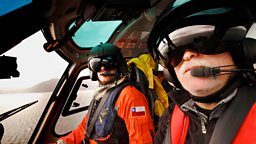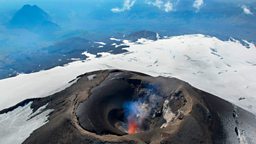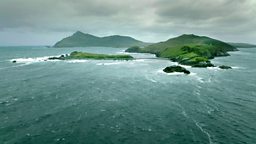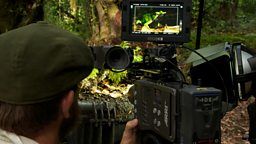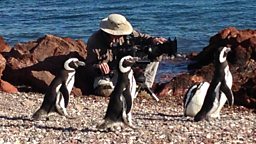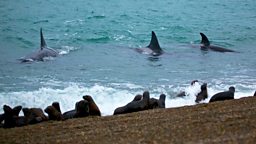Aerial filming in Patagonia
Ron Chapple, aerial director of photography
My first call to film aerials for the Patagonia project came from producer Tuppence Stone. She asked if we might consider a project to film aerials of Patagonia. At that time my thoughts of Patagonia were of a location of mythical proportions in the far south of South America.
my thoughts of Patagonia were of a location of mythical proportions in the far south of South AmericaRon Chapple
My first read of the script described Patagonia as foretold by the old sailor’s wisdom that “below 40 degrees south there is no law; below 50 degrees south there is no God.” Tuppence was asking us to fly through some of the most extreme environments in the world. We happily accepted!
For an aerial project that will take place at the ends of the earth months of preparation are needed. We sourced the helicopter company, an experienced pilot, and worked out the flight routes. Unlike working in Europe or the United States, we needed to think 2-3 steps ahead to arrange for jet fuel to be delivered to our landing zones.
After back to back flights from Los Angeles we arrived in Santiago (via Miami!) in the early morning, cleared customs, and dragged ourselves and our 10 cases of gear across the street to the airport hotel. After a few hours of much needed sleep we met with Rene Araneda, our location manager, to go over final details. Planning an aerial shoot is a dynamic process: locations can change based on weather which means that we might need to re-book hotels frequently and arrange alternative transportation.
Working on location also means being flexible. I often feel that the one thing I know for sure when I wake up every morning is that I have no idea where I will be staying that night! We looked through many maps and beautiful images of the areas we were about to film.
Once the kit was rigged our plan was to fly south to Punta Arenas and then onto the village of Puerto Williams on , just across the Beagle Channel from Argentina. From Puerto Williams we planned on filming the glaciers which marched down from the mountains of into the northern reaches of the Beagle Channel.

Patagonia explored: Eye in the sky
Fly behind the scenes with Patagonia's aerial filming team.
If we were lucky, we would attempt a flight out to Cabo de Hornos (Cape Horn). Pablo Blanco, our pilot, started checking weather. Pablo explained that there was a certain mountain pass that we would have to fly through, and that predicting weather for this location was an art not a science. We could only discern general weather patterns.
Cabo de Hornos is at 55 degrees...we had just survived the old sailors adage of “below 50 south, there is no god”Ron Chapple
Pablo pulled me aside and said “Ron, the locals here call this Death Pass... we only have one chance to make it through as there will not be enough fuel to return to Punta Arenas”. I fell asleep that night with my head spinning around the words... Death Pass, Patagonia, one chance... and wondering why I ever accepted this opportunity from Tuppence!
Once we finished breakfast, after a few concerns the weather was looking good and Pablo wanted to make a try for Puerto Williams. The first part of the flight was uneventful as we crossed the Strait of Magellan. We soon turned slightly south and climbed towards the mountains, and within minutes we were almost in the clouds with only 100 metres above the ground below. And then, the valley dropped away... we were through Death Pass.
Our 2 day wait was rewarded with amazing vistas as the valley stretched out in front of us. My nervousness turned to sheer visual delight as we came across wild horses at the juncture of two braided rivers.
Next, we were heading to Cabo de Hornos . If Patagonia is a mythical location, then Cabo de Hornos is somewhere between epic and “Are you kidding me, we are going to fly to the edge of the map?” After Cabo de Hornos, the next stop is Antarctica... in the next 45 minutes, we were going to fly to the edge of the map!
, Chile is not a singular point of land, but an archipelago of islands. The wind can be perfectly calm on one side of an island and funneled to hurricane strength on the other side.
We continued our way south and within a few minutes, we could see the last piece of land: beyond was an angry sky engorged with black clouds and rain. We would only get one chance at the shot before our helicopter, camera, and lens would be immersed in nature’s wet fury. Perhaps knowing that you have only one chance at the shot is what calms the nerves.
The jet turbine strained against the gale force winds as the helicopter blades chopped through the turbulent air. As we flew low over the crashing waves towards the edge of the map, I knew we had our shot. Cabo de Hornos is at 55 degrees...we had just survived the old sailors adage of “below 50 south, there is no god”.
In a land like Patagonia, the only way to become complacent would be to lock yourself in a hotel room. The land has so many stories to tell us, it is alive. Sometimes, simply the light was amazing, and other times the power of a thunderous waterfall would take our breath away. Ice is balanced by fire, and Patagonia is truly a land of ice and fire.
In a land like Patagonia, the only way to become complacent would be to lock yourself in a hotel room.Ron Chapple
I have flown around dozens of volcanoes, and watched as the bottom of a helicopter chin bubble warped from the heat of the flowing lava on the Big Island of Hawaii. These experiences were simply introductory training for filming Mt. Villarrica. As we lifted off, faint plumes of smoke were visible. Pablo skillfully navigated us closer and closer to the caldera at an altitude of almost 3,000 metres.
Mountains and especially volcanoes create their own weather. In the light air of Mt. Villarica, the mountain quickly showed us that we were not in control, but simply invited guests. Our host did not disappoint as 15 metre explosions of molten lava blasted into the sky.
Within 36 hours, made world news headlines with a violent eruption tossing lava and molten rock hundreds of metres into the sky.
Filming a land like Patagonia is a privilege and a responsibility. Only nature lets you in, and nature does so on her own terms. She doesn’t really care if you make it through Death Pass, or survive a journey to the edge of the map. Nature opens up the opportunity, and you are welcomed only if you make a promise to share the beauty. This was our opportunity, and our responsibility.
